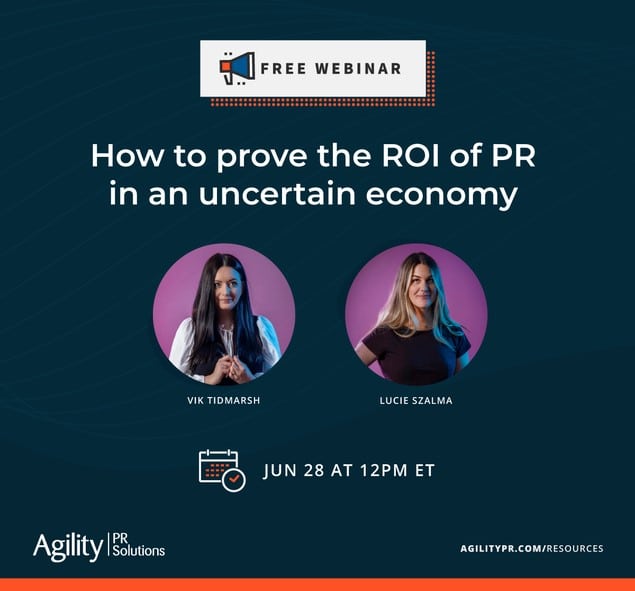It’s the unfortunate reality that during economic downturns, as businesses look for ways to cut costs, their eyes often land on the advertising, marketing, and the PR and communications departments.
 In a timely webinar, Lucie Szalma, Senior Account Director, and Victoria Tidmarsh, Operations Director at Hatch, joined Agility and Bulldog Reporter from the UK to talk about proving the ROI of PR in an uncertain economy. We’ve put together a quick recap of their presentation below. For their full presentation, including case studies and Q&A, watch their webinar for free and on-demand.
In a timely webinar, Lucie Szalma, Senior Account Director, and Victoria Tidmarsh, Operations Director at Hatch, joined Agility and Bulldog Reporter from the UK to talk about proving the ROI of PR in an uncertain economy. We’ve put together a quick recap of their presentation below. For their full presentation, including case studies and Q&A, watch their webinar for free and on-demand.
Defining PR and ROI
PR pros have a challenging job. As Victoria says, “We need to know everything about everything.” In PR, you must be an expert on your client or brand’s sector(s) so you can advise on which conversations to be involved in and where the opportunities are within the current news agenda. In addition to this already substantial job description, Victoria says, “Coverage alone is no longer enough for PR—we are a contributing factor in the consumer purchase journey. Now we can track links, we can look at direct conversions from coverage, we can tap into viral trends on social media and use all of that to help the sales channels as well.”
The change in scope is accompanied by a change in strategy—particularly for reporting on PR’s ROI. “It’s simple to find yourself as a PR person delivering lots of different things but not actually reporting on what you’re doing and therefore not showing that value,” says Victoria.
Lucie and Victoria define ROI as, “the long- and short-term profitability of whatever it is you are delivering.” The break down profitability into two categories:
- Monetary gains: things like sales conversions, leads, or event attendees
- Earned media: anything that improves a brand’s credibility or reputation
“Earned media is very much the start of the process,” says Lucie. “While it’s sometimes difficult to convince people or clients of the actual ROI, it is important to recognize that by gaining earned media, you are more likely to encourage your target consumers to go on that journey with you, which will eventually lead to something more tangible.”
Why you shouldn’t turn PR ‘off’
“Before we delve into how best to measure PR, we need to also think about external or cultural factors and how they can influence or impact how we plan, execute, and even report on PR activity,” says Lucie. She mentions some current examples: the war in Ukraine, the rising cost of living, and the lingering effects of the pandemic. “When factors like this take precedence, it’s often marketing that is the first to have budget cuts and then, naturally, ROI is thrown into question. For PRs, it means that we’ve got a really important job to do. We must recognize that in some cases brands may want to err on the side of caution, but it’s our responsibility as consultants to ensure that whatever we do or suggest is considered well timed and in good taste.”
One idea Lucie and Victoria brought up several times during the presentation is the need for brands to not shut off their PR activities during difficult times. Lucie says that because of the pandemic, “many [brands] felt that they were faced with a decision of either pulling the plug on their current plans or reevaluating their strategy entirely. And national lockdowns only exacerbated this, and it meant that some brands were simply unable to operate as normal as things, like supply chains, were affected.”
Lucie and Victoria shared several examples of what happened when brands pulled back on their ad and PR spend during the pandemic. For instance, “Coca-Cola decided that since we were in lockdown and people weren’t out and purchasing in their usual ways that the [advertising] investment needed to be reconsidered,” says Lucie. “And as a result, they found that Pepsi stole 5% of their anticipated revenue growth for 2020.”
Victoria adds, “These are big brands with big brand awareness and big budgets. You can assume the impact on smaller brands was much greater.”
Losing revenue, stagnating growth, and watching your customers switch to your competitor are all possible consequences of reducing or eliminating your PR budget.
“The reality is that there are lots of brands out there now who are all competing for the same place,” says Victoria. “So again, if you as a brand switch off—even if you’ve got a brilliantly engaged audience—you are very likely to lose some of your audience if your competitor ramps up their activity, So, the focus for us as PR people is to make sure that we are constantly evolving and proving to our brands or to our bosses why this activity should be continuing.”
Understanding what success looks like
Before measuring, or even planning your brilliant strategy, you need to have a conversation with your client. As Victoria says, “It’s easy for us to assume that a high volume of coverage with loads of brand mentions driving thousands of visitors to the website is going to make your client happy at the end of the month and it may well, but they also might turn around and say to you, ‘That’s great, but I really wanted to see the brand in the Daily Mail’, or ‘I really wanted to us to get on TV’, in which case you may have gone about your strategy slightly differently.”
The second half of the conversation should be to determine what the client is currently doing that will allow you to track and report on success. “Ask questions like, what you are measuring currently, what’s worth tracking and isn’t, are you seeing any arbitrary numbers that have no business value, and how can we look to impact those numbers?” says Lucie. “And also put forward honest, genuine recommendations on exactly what they’re measuring.”
Wrapping up
To conclude their presentation, Victoria left attendees with the following advice: “Make sure your expectations are aligned so you, your clients, your boss, all understand what’s achievable. Data is really important. If you can get access to client data, it’s even better, but also try and add your own layers of insight on there. And then finally, play nice. Make sure you’re integrating across different teams and different specialisms. You’re all ultimately working towards the same goal and if it helps make your PR report look stronger at the end of the day, that’s what you should be doing.”
For more from Lucie and Victoria, watch How to prove the ROI of PR in an uncertain economy free and on-demand.








